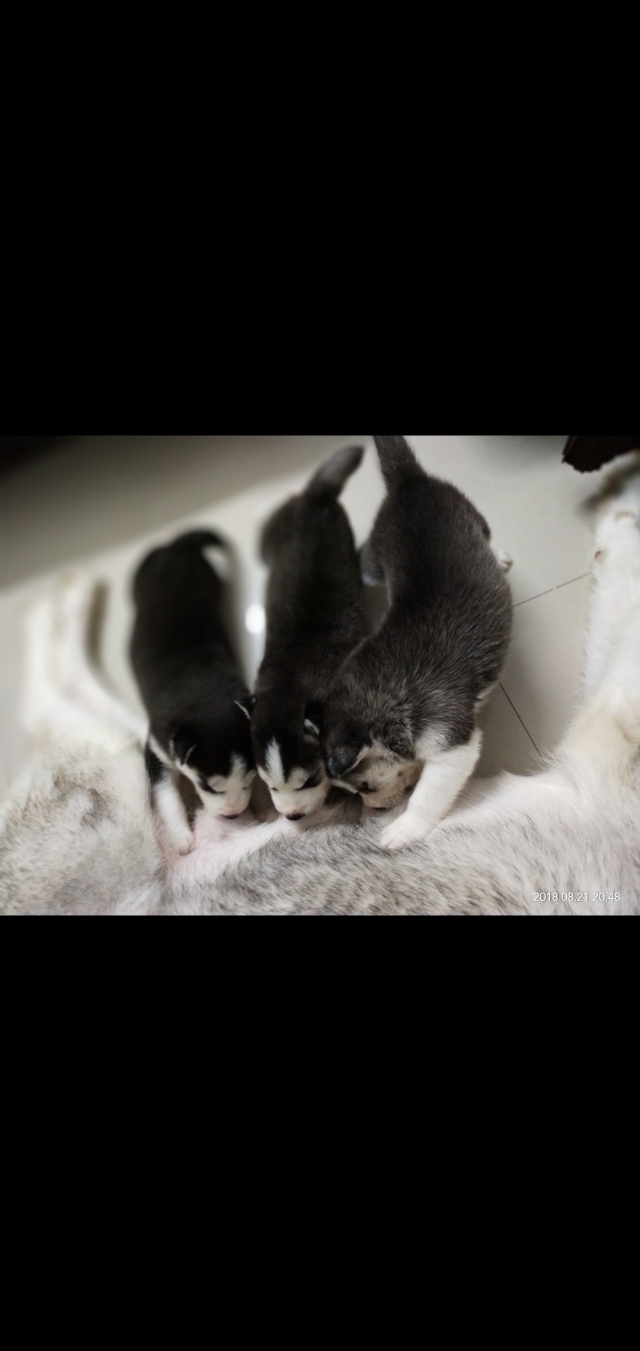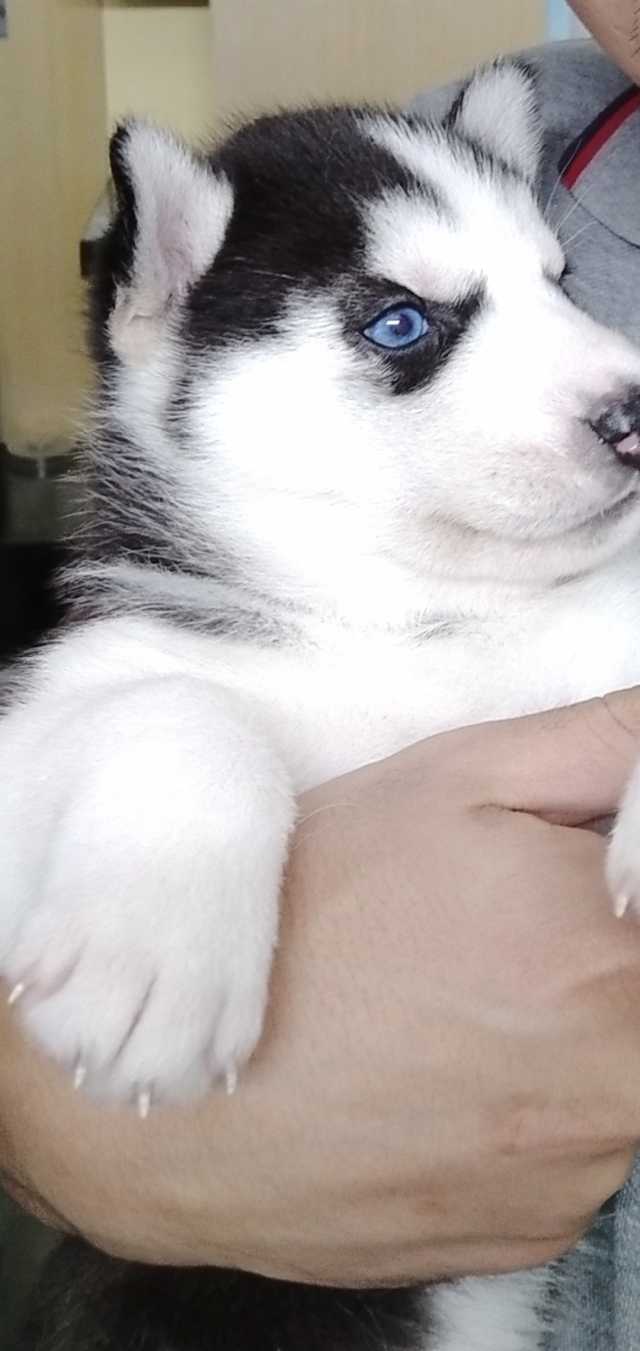Syberian husky puppies with blue eye and gray eyes
|
|
Siberian Husky |
|
|
30 days |
|
|
Yes |
|
|
Contact Me
|
|
|
Male |
|
|
Black and white |
|
|
Yes |
|
|
Aug 31, 2018 |
|
|
Sold Out |
About Puppy
We have 30 days old certified Syberian husky puppies. very healthy and ready to move lovely homes. contact me via whatsapp for more photos.
1-black and white with blue eyes high quality female
2-gray and white with blue eyes high quality felame
3-gray and with with gray eyes high quality male
Breeders Contact Details
Are you interested to contact the owner
Login
Register
Siberian Husky
Country of Origin
The Siberian Husky (also known as the Chukcha, Keshia, or Arctic Husky) originated as a sled dog for the Chukchi tribe of Eastern Siberia (in northern Russia) several thousand years ago. It was imported to Alaska in the early 20th century during the Alaskan gold rush. The Siberian Husky attracted attention when it completely dominated native breeds in the 400 mile All-Alaska Sweepstakes race from Nome to Candle in 1910, the second year in which it competed. It gained further prominence in 1925 when a gold miner named Leonhard Seppala used a now-famous team of Siberian Huskies to make an urgent delivery of diphtheria serum to Nome, saving thousands of lives. This delivery became known as the Great Race of Mercy and attracted much attention to the Siberian Husky. A statue honoring Seppala's team stands today in Central Park. In 1930, Russia allowed the last group of Siberian Huskies to be exported from Siberia; the breed was recognized by the American Kennel Club that same year. Most Siberian Huskies today descend from the 1930 exports and Leonhard Seppala's team. Today the Siberian Husky is one of the most popular northern breeds, serving as a pet, sled racing dog, and show dog. Siberian Huskies appear prominently in Disney films Snow Dogs, Eight Below, and Iron Will, all based to some degree on true stories of heroic Siberian Huskies. Siberian Huskies are the mascots of Northeastern University and Michigan Technological University. A female Siberian Husky mix named Laika became the first animal to enter orbit when she was launched into space on Sputnik 2.
Size
The Siberian Husky has a shoulder height of 51-60 cm (20-23.5 in) and weighs 15-28 kg (35-60 lbs). It has a round skull with almond-shaped eyes and triangular, erect, furry ears. Some Siberian Huskies have a winter nose which fades to pink in the winter; the color change can be permanent in older dogs. The Siberian Husky's eyes are blue, green, brown, or hazel. Bi-eyed Siberian Huskies have one blue eye and one brown or hazel eye while parti-eyed Siberian Huskies have irises of blue mixed with another color. The Siberian Husky is one of only a select few breeds which is allowed different-colored eyes in the show ring, and one of only a few breeds to commonly have blue eyes. Siberian Huskies have an arched neck, sickle-curved tail, and furry, oval feet. They have a wolf-like appearance.
Coat and Color
The Siberian Husky has a dense, smooth undercoat and coarse outer coat of short, straight hairs. Every color and combination is acceptable; common colors are pure white or white with black, grey, or copper-red, all with possible blond markings. There are a variety of striking facial markings. Siberian Huskies shed twice a year.
Character
The Siberian Husky is adventurous, clever, and stubborn. It wants to be everyone's friend, a fact that makes it a less-than-ideal watchdog. Siberian Huskies love to wander, and they are full of energy and independence. The Siberian Husky is known to stage frequent and elaborate escape attempts by jumping over or tunneling under walls. It is very energetic and active when playing, and tends to make interesting whoops, yowls, and ululations.
Temperament
The Siberian Husky gets along well with other Huskies, but needs to be trained carefully to interact with other household pets. It tends not to get along with cats or other small animals. Siberian Huskies deal well with children. It is wise to have more than one Siberian Husky because they do not enjoy being left alone.
Care
Siberian Huskies require weekly grooming with a brush and comb, particularly on the rear legs, more often when shedding. Bathe only when necessary. The Siberian Husky has a lifespan of 10-14 years. It is generally healthy, but prone to eye problems such as glaucoma and cataracts, and cancer when older. The Siberian Husky has a high propensity for obesity if under exercised, and requires less food than one might expect for its large size; consult your veterinarian for dietary information. Fish oil, which can be found in sardines or flaxseed oil, is a recommended part of the Siberian Huskys diet. The Siberian Husky is not well suited to warm climates; it needs a cool place to sleep in the summer.
Training
The Siberian Husky will only obey commands that make sense to it. It is very independent-minded, so handlers need to have considerable patience and a good understanding of the Siberian Huskys nature.
Activity
The Siberian Husky was bred to pull a heavy sled for countless miles; it demands to be involved in physical activities. If you can't have it pull a sled, let it run alongside you as you jog or ride a bicycle, ideally for at least an hour every day. Siberian Huskies that do not get enough exercise become destructive and loud. They have a low heat tolerance, so do not over exercise them in warm weather. The Siberian Husky is not suited to apartment life.









